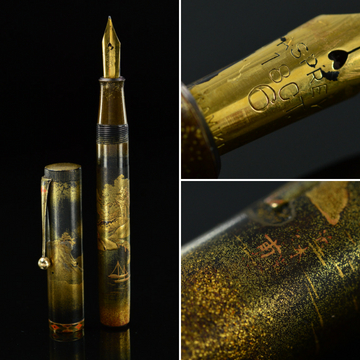Rare fountain pen could be write stuff
A rare maki-e fountain pen which encapsulates an ingenious and inimitably Japanese intricate attention to detail is coming up for auction at Staffordshire auctioneers Richard Winterton’s.
Discovered in a box of assorted pens, the highly detailed 130mm-long lacquerwork writing instrument features the built-up designs of takamaki-e and the cloud-like nashiji techniques extensively covering the cap, from top to cap ring, and the barrel from nib to base.
 The pen will have an estimate of £6,000 to £7,000 in the sale on June 20.
The pen will have an estimate of £6,000 to £7,000 in the sale on June 20.
“This item was discovered in a box of pens from a house clearance and is a really significant find,” said Richard Winterton. “The surprise on the face of our pen valuer was something to behold!”
The cap is decorated with miniature scenes of a nashiji clouded sky over a craggy mountainside with trees and foliage, with a gold-coloured clip and ring which has engraved and re-lacquer detailing to them.
The cap is 65mm in length and 14.5 mm in diameter.
The barrel has highly delicate and intricate scenes of a forested hillside with many rocky crevices, with intricate takamaki-e detail in the leaves and trees, overlooking a tidal lake connected a rocky island by a wooden footbridge and two sailing vessels at rest and moored on the lake.
It has a yellow metal straight fill lever and, to the lower right of this, bears the artist’s signature, partially obscured by nashiji gold dust detailing.
The nib has a heart shaped vent and is stamped 18ct, 6, Namiki and Asprey. This dates this pen to between 1925, when eminent retailers such as Cartier and Asprey started to market these pens to the world, and 1929 when Dunhill began their exclusive collaboration with Ryosuke Namiki under the Dunhill Namiki brand name.
The barrel is 120mm from the tip of the nib to its base and 12.5mm in diameter.
The term ‘maki-e’ means ‘sprinkled picture’ – created through a painstaking process of applying colourless lacquer to then be sprinkled with gold dust or pigments to eventually build up a design.
Building up layer upon layer using different colours and different techniques creates intricate designs with incredible depth which are inimitably Japanese.

